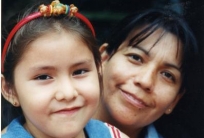You are here
Expanding the Way We Look at Health

As a health funder, we field many inquiries about supporting disease-specific work; preventive care, such as children’s immunizations; and lifestyle change, including helping individuals eat better and move more. All are important.
In 2006 Blue Cross and Blue Shield of Minnesota Foundation introduced Growing Up Healthy: Kids and Communities, a statewide grantmaking initiative to improve the health of Minnesota’s children in low-income communities through a focus on social and environmental determinants of health. At times, we were met with puzzled looks when we explained that there’s a community component to good health beyond the responsibility of the individual — that housing, indeed, has something to do with health. And that early care and learning experiences affect health for life. Even the idea of collaborating across these sectors — creating partnerships and working together on a community condition toward a common goal—was new to some.
The goal of the initiative is to build strong and connected communities where children can thrive and grow up healthy by working at the intersection of health and two or more of the following key health determinants: early childhood development; stable, affordable housing; and the environment. To date, the foundation has invested $4.4 million across 30 grantees and spent $1.1 million on evaluation, convenings and other consulting. Commitments to current grantees extend through 2014 and total $1 million.
The Initiative uses a two-pronged approach to the grantmaking, through planning grants followed by implementation grants. While working in collaboration sounds like a great idea, we all know that it isn’t always easy. And because it takes time to develop relationships, we offer a $25,000, one-year planning grant to one organization to lead community partners in developing place-based projects (neighborhood, town, region) that address health and at least two of the three determinants: early childhood education, housing and the environment.
At the end of the planning period grantees develop a community vision (unique to each community and developed by the community), supported by a written implementation plan for three additional years of funding of up to $150,000.
Grantee Highlights
Heartland Community Action Agency developed the Healthy Foundations Project focusing on children to age five. In a four-county area, one in five preschoolers is expelled from child care settings because of challenging behavior. Instead of looking at this as solely a behavior problem, the project is looking at environmental triggers that may contribute to the behavior. Armed with an XRF scanner provided by Coming Clean, Healthy Foundations is holding events where the public can bring in items to be tested for arsenic, bromine, cadmium, chlorine, lead and mercury. Project staff members also are testing common items found in child care settings, such as vinyl cots, Legos and other items that children frequently touch or even put in their mouths. Additionally, staff members are working with child care providers, creating healthy cleaning kits and providing recipes for healthy cleaning products. The goal is to increase awareness of the potential dangers of common household and child care setting products, reduce their use or replace them with safer alternatives, and ultimately help children be healthier and more successful in their education.
Northwest Regional Sustainable Development Partnership at the University of Minnesota received six grants over six years for a three-pronged project aimed at reducing children’s exposures to pesticides. One project in the Red River Valley, a primarily agricultural region, a Photovoice project asked three groups of women to photograph and give voice to actions or activities that they believed could potentially harm their children’s health. An exhibit with these photos and stories traveled the state, including the Minnesota legislature, to foster discussions on the impact of pesticides and how safer practices could be instituted to benefit the health of the area’s children. The project also developed a curriculum that federal supplemental nutrition program (also referred to as WIC) and public health nurses could use during home visits to help increase parents’ and caregivers’ awareness of potential toxins in the home and child care environments. A third component involved the White Earth Tribal and Community College and the Anishinaabe Center on the White Earth Reservation. With plants from the Anishinaabe Center greenhouse, the organization developed a garden mentoring project to help residents re-connect with traditional foods by planting their own gardens. In conjunction, a class in foraging for wild edibles was developed at the Tribal College so that young children and teens could learn more about healthy, traditional Native American foods that are an important part of their culture.
The National Center for Healthy Housing (NCHH) conducted a first-of-its-kind study with Blue Cross and Blue Shield of Minnesota Foundation funding on the health impacts of green housing renovation. When a 70-unit low-income apartment complex in Worthington, Minnesota, was renovated, the NCHH conducted a survey to document the health benefits of green renovation. The renovations to the three apartment buildings in southwest Minnesota yielded improved housing conditions. Fewer moisture and dampness issues, little or no pest problems, and less use of devices (e.g., incense, cigarettes) that cause smoke indoors made homes easier to clean, more comfortable, and safer both inside the apartment and outside in the community. These housing improvements yielded better health outcomes for residents, particularly adults, whose overall health significantly improved over the course of the study. A few health problems showed a large improvement, such as fewer children reported to have respiratory allergies and ear infections, and significantly fewer adults reported to have illnesses such as chronic bronchitis, hay fever, sinusitis, asthma, and hypertension. This study has been used to help pave the way for other green renovations, including a senior housing complex in Mankato. Awareness of the benefits of green renovation led Minnesota to become the first state to require that green principles be used in all renovation of low-income housing in the state.
Next Steps
The initiative was designed to roll out in three phases. The first phase is complete, with a summary report available including lessons learned (see Growing Up Healthy results). In the second phase of the initiative we added a collaborative leadership training program to assist grantees with skills and tools to develop and implement action plans that are grounded in the needs of the community, have broad-based support and can lead to sustainable change for children. This included grantee site visits, three two-day residential retreats and individual technical assistance through face-to-face visits at grantee sites and by telephone and email. A progress report on the second phase also is available (see Growing Up Healthy phase II report). Currently we are reviewing the lessons learned during the first two phases. We’ve been encouraged by the progress of these projects and are planning for 2014 and beyond.
Interested in seeing more of BCBS' work in Minnesota? Check out Twin Cities Public Television's program on Growing Up Healthy here.
Carolyn Link is the Executive Director of the Blue Cross and Blue Shield of Minnesota Foundation. The Blue Cross and Blue Shield of Minnesota Foundation exclusively dedicates its assets to improving health in Minnesota, awarding more than $32 million since it was established in 1986. The Foundation’s purpose is to make a healthy difference in people’s lives by improving the conditions that affect the health of children and families in low-income communities.
From our Blog
Upcoming Events
|
Jul 29 2024 Zoom |
Jul 30 2024 Zoom |

